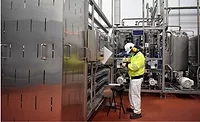Tech Update: Robotics
Robotics now and in the future
With technology advances, robots have convinced many processors that they are worthy of hire, speeding production while improving quality and food safety.
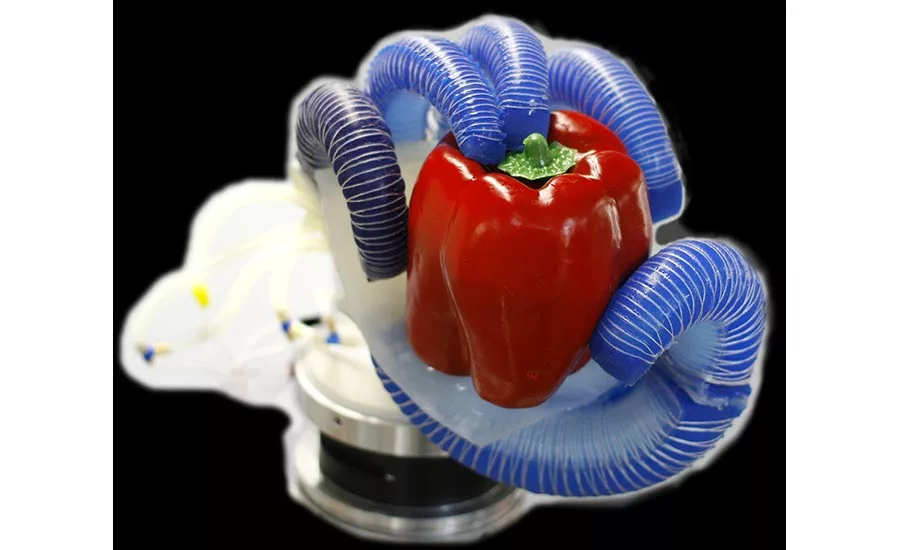
Special grippers for soft/delicate food are often in development, such as the RBO Hand 2 at the Technical University of Berlin, Department of Computer Engineering and Microelectronics. The gripper hand is made from PneuFlex actuators mounted on a flexible, printed scaffold. Source: Technical University of Berlin.
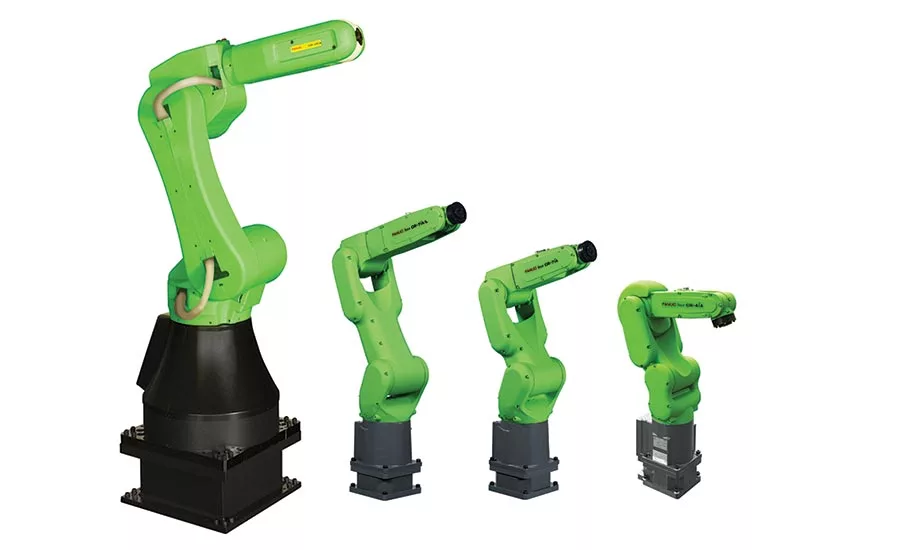
FANUC has a complete line of collaborative robots (CR Series) that are force limited and work without the need for fencing, but can handle payloads from four to 35 kg. Source: FANUC.
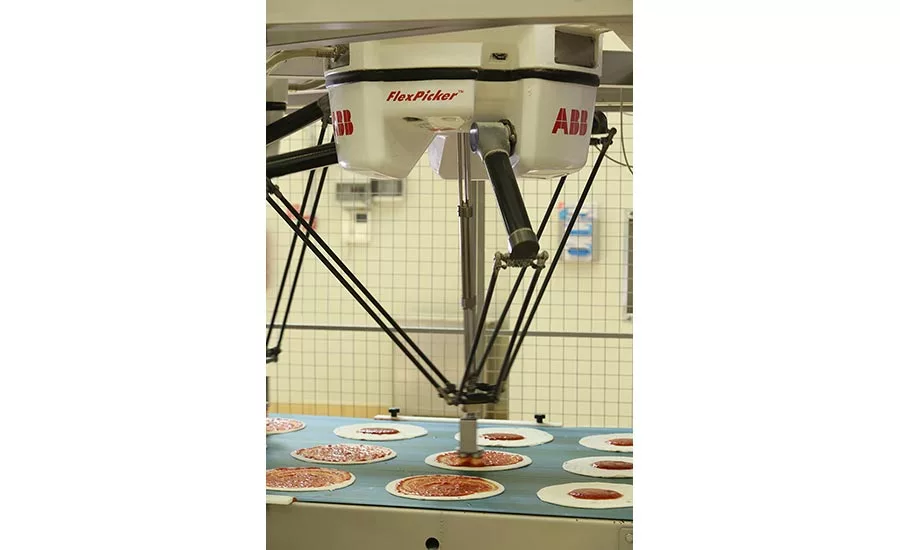
Able to spread tomato sauce perfectly on pizza dough, ABB’s FlexPicker can cover thousands of pizzas a day, so no human has to do this repetitive, monotonous task. Source: ABB Robotics.
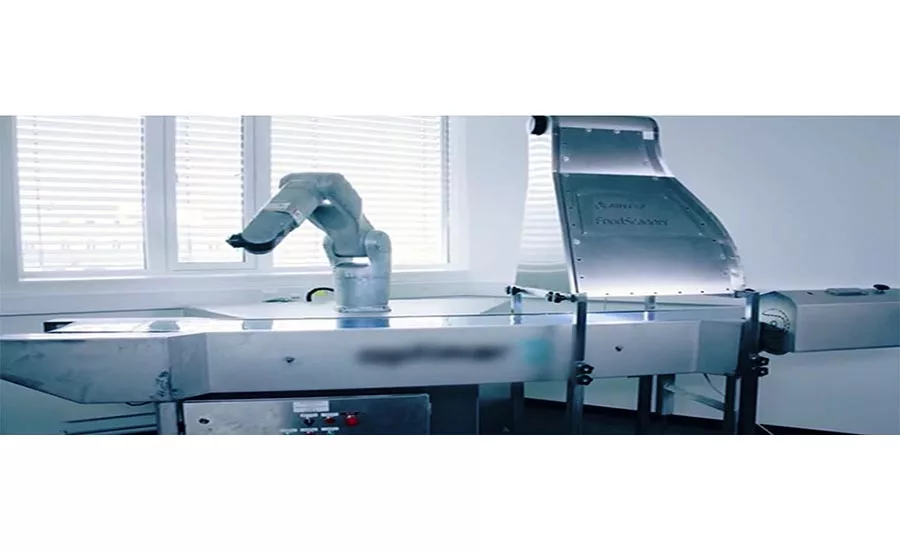
Denso Robotics created this robotic fish-cutting system when needed by a client. The hygienic system scans the fish before trimming it to size. Source: Denso Robotics.
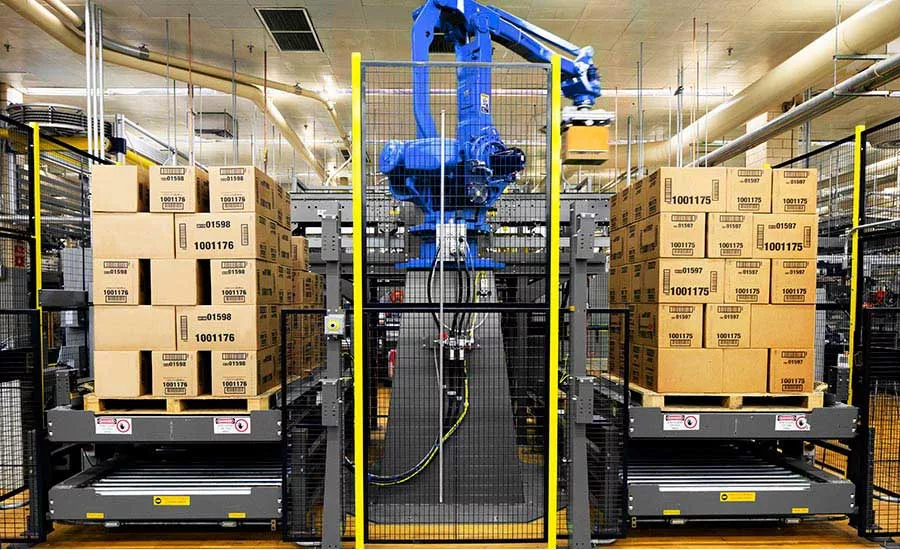
Intelligrated offers full robotic system integration of robotic palletizing and de-palletizing systems, including conveyance and sortation products to implement complete systems. Source: Intelligrated.

Festo’s Bionic Tripod 2.0 consists of a drive unit, a tripod structure free to move in all spatial directions, a flexible hand axis and an adaptive FinGripper soft handling unit, which consists of a pneumatic actuator and three lightweight gripping fingers. Source: Festo.
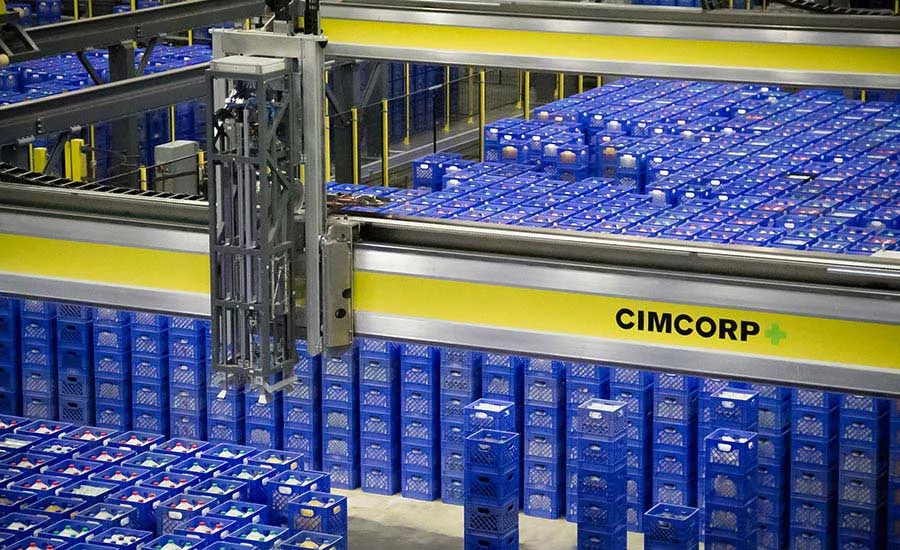
Kroger selected Cimcorp’s Multi-Pick, a fully automated, robotic production storage, handling and order processing system, which is able to pick 32,000 crates per day from a store of up to 36,000 crates. Source: Cimcorp.
Mention the word, “robotics,” and you probably think of the auto industry. After all, that’s where robots got their start—on assembly lines doing the drudge—and sometimes, dangerous—work. But the food industry is no slouch in employing robots, especially for hazardous and back-breaking jobs.
Article Index:
- Meeting environmental demands
- New applications—new technologies
- A place for collaborative robots
- What’s the cost to give people a break?
- The future is flexibility
Technavio’s recent market study for the global use of SCARA (selective compliance articulated robot arm) robots in the food and beverage industry predicts a steady compound annual growth rate (CAGR) of 25 percent over the period from 2016 to 2020. But it’s not so much that giving robots unhealthy-for-human jobs is driving the adoption of robots; instead, it’s changing regulations.
Ingress protection ratings such as IP65, IP67 and IP69K show that robots are designed to withstand the penetration of dust and varying degrees of water and steam, making them easy to clean and preventing the harboring of bacteria on the outside of the robot and under the housing. These ratings imply that robots are fit enough to handle food materials and products directly because they can be easily cleaned.
Robot manufacturers have been challenged by regulations because there has been no one standard set of specifications for robots in the food and beverage industry. Often, robot makers relied on FDA, EHEDG and/or other regulations describing food equipment and contact surfaces.
Recognizing the lack of a single standard for the food industry, 3-A Sanitary Standards Inc. (3-A SSI) put nearly five years of effort into creating a new sanitary standard for minimum sanitary (hygienic) requirements for the design, materials and fabrication/installation of robot-based automation systems (RBAS). Released late last year, 3-A Sanitary Standard for Robot-based Automation Systems (Standard Number 103-00) applies to the hygienic applications of industrial robot systems integral to food processing, preparation or other applications or industries where process equipment cleaning and sanitization are required.
The standard applies to the robot and ancillary robotic system equipment, including the robot base, end-of-arm tooling (EOAT), tool changers and robot dressing. Specifically, the new 3-A SSI standard includes materials and fabrication requirements, as well as special requirements unique to robot systems, including zone considerations, programming requirements, controller requirements, wiring/robot dressing requirements and tooling and installation.
Not yet widely accepted in the food industry is the collaborative robot, which can work closely with humans in a safe environment. Limiting factors to wide food industry acceptance include the lack of design for clean and washdown environments and performance levels, which can’t match dedicated SCARA and Delta-style robots for packaging/palletizing and pick-and-place operations. Yet, Technavio predicts, in general, the global collaborative robots market for all industries is expected to increase at a CAGR greater than 60 percent by 2021.
Meeting environmental demands
Robots have been generally used in secondary packaging and palletizing, but haven’t all been able to meet the rigors of processing environments.
“This is a large challenge but not impossible,” says Steve Bain, Festo industry segment sales manager—food and beverage. “The same principles that allow gearboxes, conveyors, linear actuators and other dynamic movements to operate in aggressive environments can be utilized for robotics. In general, this requires more expensive and heavier materials, both of which can increase the cost of the robot. Different sealing material may cause more friction, increasing force requirements and necessitating more frequent maintenance intervals compared to standard robotics.”
But these challenges are already being met by several robot manufacturers. While having the new 3-A SSI standard is helpful, most robotics suppliers have been dealing with meeting the rigors of food plant environments for some time.
“Stäubli Robotics has developed our Humid Environment [HE] line of robots specifically designed to withstand the demands of daily washdown practices in the industry,” says Sebastien Schmitt, robotics division manager, North America.
These robots are optimized for the food and packaging industry and feature a smooth, specially treated, chemical-resistant surface to eliminate collection areas, very tight seals and pressurization of the arm to eliminate migration of water to the inside of the arm. They can also use H1 food-grade oil and have stainless steel (SS) wrists to minimize risks of contamination, says Schmitt. The HE machines were designed according to EHEDG directives, as well as the Machine directive 1935.2004 (revised 2006) and the Health and safety section EN 1672-2.
FANUC is building robots specifically for operation in the process area and with cleanability and the ability to withstand washdowns, says Wes Garrett, authorized system integrator and account manager, FANUC America.
“We look at everything, including casting shapes with curved surfaces; no crevices for bacteria buildup; fine surface finishes; and hex head stainless hardware,” he says.
Developing purpose-built robot arms makes it much easier to obtain higher IP (ingress protection) ratings required for washdowns, cleanability and durable surfaces for the primary processing areas.
ABB has provided IP69K high-pressure (80-100 bar), high-temperature water (80°C) protection for the IRB 360 Delta robot for more than 10 years, says Richard Tallian, ABB Robotics, business development—packaging business line.
“The washdown process requires the usage of materials resistant to high-temperature/high-pressure water contact, as well as cleaning and sanitizing agents,” Tallian says. “Operating in and over the ‘food zone’ has also required these robots to operate with food-grade lubrication and FDA-compatible materials.”
“Leading robot manufacturers like FANUC are providing food-grade robots that are specifically designed for the requirements of the food processing industry,” says Michael Lindley, VP marketing and business development, Concept Systems Inc., a member of the Control System Integrators Association. “These robots are capable of full washdown and are proven to provide higher levels of sanitation, considering that they can run in higher-temperature environments.”
Robot manufacturers often gain valuable experience from one market and transfer that knowledge to others, such as from pharma to food and beverage. Using SS to produce a robot that meets food-grade requirements is one important food safety criterion, but for a company that also makes robots for process areas in the pharmaceutical environment, there are other demanding criteria that the robot must meet, according to David Robers, Denso Robotics regional sales manager. For example, a pharma robot must be capable of withstanding ultraviolet radiation and 35 percent vaporized hydrogen peroxide sterilization.
There’s yet another environmental concern that robotics manufacturers are considering—operating in cold environments.
“Over the last few years, we’ve seen advancements made in robotics, including making them easily applied to cold room, freezers and washdown and processing areas,” says Bruce Bleikamp, Cimcorp sales manager. “We recognize the growth in frozen food handling and are currently investigating [at] what temperatures our products will work best to capture this market.”
New applications—new technologies
Robotics applications stretch from processing to primary and secondary packaging to warehouse operations—whether it’s securing ingredients for a process or storing/sorting finished products—to whatever can be imagined. According to a new study from Markets and Markets, warehouse robotics across all industries will be a $4.4 billion market by 2022, growing at a CAGR of 11.8 percent between 2017 and 2022. Warehouse robotics includes a number of robot types, for example, mobile, articulated, cylindrical, SCARA, parallel and Cartesian.
Cimcorp’s Bleikamp describes popular applications among his clients—layer picking and crate and tote handling. Layer picking is ideal for the food industry because many food and beverage companies process less-than-full pallet orders.
“We offer a cost-effective and labor-saving means to pick layer quantities from a larger number of SKUs. We have the ability to place a full pallet into the processing area in one move. We then pick layers as needed—oftentimes, picking two or more layers at a time,” says Bleikamp.
The layers are then placed onto order pallets, which can then have other SKUs added to them, be prepared for shipping or topped off with other SKUs in less than a layer quantity.
Cimcorp offers two solutions for crate and tote handling—Multi-Pick and 3D Shuttle. With the 3D Shuttle, crates can be stacked and moved as needed to sort product and process orders. Any tote or crate within a stack can be moved without shuffling crates. With these capabilities, the 3D Shuttle acts like an AS/RS in staging product. The supplier’s layer Multi-Pick robots use sensors and grip technology so they can see where the product is located and handle product as lightly as possible without dropping or damaging it.
In material handling applications, the main objective is speed—moving from the pick location as fast as possible.
“In most robot configurations, you have to begin with a mechanism that is as lightweight as possible and still provide a rigid design for the payload and reach configuration of the arm,” says ABB’s Tallian.
This is coupled with servo motors and gearboxes that can provide the acceleration movement of each axis.
“But the real key is motion control—providing the best motion algorithms for the complete system,” adds Tallian. “Utilizing ABB’s dynamic model-based QuickMove2 and feed-forward servo control, TrueMove2 algorithms allow our robots to perform moves 25 percent faster and maintain accurate path control at any speed.”
As FANUC robot models are newly developed or updated, speed and duty are evaluated very closely, says Garrett.
“To obtain higher speeds, robot arms must be as light as possible, yet remain very durable and rigid. As for duty, the motors must be of adequate size to ensure that overheating will not be an issue. FANUC also offers optional fan kits for additional duty capabilities,” he says.
The robot builder uses finite element analysis (FEA) techniques to optimize for the best robot arm design and makes use of its ROBOGUIDE software to simulate real-world applications and benchmarks during the design phase.
Technology transfer from other industries, such as the aforementioned pharma, helps improve on designs for the food and beverage industry.
“Robots from Denso are, by design, developed for precision automotive applications,” says Robers.
Characteristics like vision integration, conveyor tracking, palletizing, packaging, washdown and submersibility are features, many of which are standard on every Denso robot—and have been requirements in the automotive, electronics and life sciences industries, adds Robers. # Using well-established technology in robotics systems has a real advantage.
“The cost of servo technology is coming down, which also has a positive impact on lowering cost,” says Jeff Smith, application engineering coordinator at Brenton Engineering. “Through improved motor and gear box design, robot OEMs can obtain greater efficiencies and speed within the same footprint. A few years ago, a leading-edge robot may have been rated at 100-kg payloads. Today, that same size robot may be rated at 700 kg.”
Complexity is less of an issue than it was before, which makes robots easier to employ.
“Plug-and-play technologies for collaborative robots are stimulating adoption because of quick and easy integration,” adds Smith. “Brenton recently purchased a servo griper for a collaborative robot. With the connection of only a half dozen wires, the gripper was fully functional.”
A place for collaborative robots
Collaborative robots (sometimes known as “cobots”) won’t win any speed contests; they work in and around humans, either directly by assisting with a task or independently by doing step-and-fetch for humans.
“We already have applications that use mobile robots in other industries that work well around people and processes,” says Cimcorp’s Bleikamp. “To date, we have not seen an application in the food or beverage industry, but we predict that we will begin to see the use of robotics in collaborative environments expand in this market in the future.”
What’s holding back collaborative robots in food applications? It’s not the concept of collaboration, but some physical limitations. However, robot manufacturers are working to overcome these issues.
“Currently, the ABB collaborative robots are not able to experience caustic wash applications,” says ABB’s Tallian. “Also, due to the force/speed limitations, collaborative robots are limited to lower-speed/payload applications. We are reviewing potential applications in baking and confectionery applications where these portable systems, such as YuMi, can be shared between multiple production activities and reprogrammed easily for short-duration production runs.”
“At this point, collaborative robots are not capable of surviving the rigors of a food processing environment,” says Stäubi’s Schmitt. “In the future, the Stäubli TX2 line of six-axis robots will eventually add HE versions and allow for industrial collaboration of production and packaging lines.”
“Practical applications for collaborative robots in the food and beverage industry are going to be low speed and in areas that are space restricted or need a lot of operator interaction,” says FANUC’s Garrett. One example includes end-of-line palletizing with rates around five cases per minute or less.
Anchored by Fanuc’s new CR-35ia collaborative robot, MGS Machine recently introduced its new Collaborative Palletizer, which is designed to work alongside humans. The robotic palletizer system eliminates the need for a safety fence, which cuts floor-space requirements in half compared to traditional robotic palletizers. The palletizer handles cases weighing up to 77 lbs. at speeds of up to six cases per minute. The robot gently stops if it comes into contact with an operator, and once the robot is stopped, the operator can reposition it before restarting the program to begin where it left off.
Just like matching the right applicant to a job, a collaborative robot needs to be applied properly.
“Rethink Robotics continues to work closely with food manufacturers to help automate tasks that were previously not able to be automated with traditional robots,” says Jim Lawton, chief product & marketing officer.
Traditional robots and automation have been designed to perform a single task extremely efficiently. But, when a production line shifts, these traditional machines need to be reintegrated and reprogrammed, which can take hundreds of hours and significant capital investment.
“In the food industry, packaging and line loading tasks shift frequently, and many companies are using Rethink’s Sawyer robot to help improve their processes,” says Lawton.
What’s the cost to give people a break?
Nearly all robotic applications relieve operators from repetitive, non-ergonomic or undesirable operations, says FANUC’s Garrett. Examples include palletizing 20- to 30-lb. cases in a freezer or packing in a refrigerated room with product being produced at over 500 pieces per minute. The return on investment (ROI) for robotics automation can vary depending on the scope of a project and the number of shifts that a user might have. ROI can be as short as three months and up to two years for more advanced systems.
Allpax Products, a maker of retort systems, offers robotic material handling solutions to load and unload packaged products for retorting.
“Typical applications require placement of an array of products in and out of retorted trays and stacking/de-stacking the trays,” says Greg Jacob, general manager.
Not exactly the type of job that people want to do, a robotic system can typically pay for itself within the first 12 months, says Jacob.
Palletizing and de-palletizing are perfect examples of physically demanding tasks—tasks where the risk of repetitive motion injury is ever present—that are better suited to a robot, says Brenton Engineering’s Smith. Also, with today’s higher-speed lines, humans simply can’t keep pace, and they’re not well suited for palletizing tall truck-height unit loads. The speed of the ROI depends on the number of workers engaged in the task, while the number of palletizing/de-palletizing applications continues to increase, says Smith.
“Many of the robotic solutions we implement are in case palletizing,” says Matthew Wicks, Intelligrated VP, product development.
Intelligrated is a system integrator of robotic palletizing and de-palletizing systems. Many of these operations still require human intervention to support exceptions that occur (open flaps, look tape, etc.), as well as support changes to packaging.
“Many of these features we have in our solution are designed for operators to resolve, since involving more technical staff can be time consuming and expensive,” says Wicks.
Robotics have been replacing some of the more odious tasks in food processing.
“One of the most interesting is a ham deboning project where the robots are used to cut and debone hams,” says Stäubli’s Schmitt. “The people were moved from this dirty and dangerous task to more productive areas of the processing facility. There are hundreds of other applications that have freed up employees to be more productive members of their companies.”
On the more delicate side is decorating cakes.
“Concept Systems worked with Dawn Foods, a commercial bakery located in Oklahoma,” says Lindley. “Concept integrated two FANUC robots with 3D vision systems to decorate cakes while they were in motion. The robotic application reduced labor, improved quality and increased throughput.”
Kroger’s newest fluid milk plant in Denver implemented a Cimcorp Multi-Pick system to become more sustainable, ensure increased efficiencies and reduce labor costs and errors. The system helped the dairy increase sorting capacity, improve throughput, enhance handling of peaks and have better use of space and fast vehicle loading.
“ROI or paybacks differ based on each facility, but in a busy operation, paybacks can be as short as one year from just labor savings,” says Cimcorp’s Bleikamp. “Most paybacks take a little longer. Another important potential benefit of implementing an automated system is fewer errors in picking. With automation, accuracy will be nearly 100 percent since all picks are verified.”
Another area of savings is in reducing the cost of injuries as employees will not be exposed to heavy lifting or repetitive motion, says Bleikamp.
The future is flexibility
“The future for robotics technology in the food and beverage industry is strong,” says FANUC’s Garrett. “As containers and packages continue to change based on customer demands and marketing, food and beverage companies need to have flexible robotic automation to handle these demands.”
Not only have robot builders had to create more flexible machines, system integrators are seeing the demand to build flexibility into systems.
“Brenton has customers that want a full auto changeover—pushbutton control,” says Jeff Smith. “To accomplish that, we offer menu-driven selection and fully automatic tool changeover. Let’s say we are working on a top-load case packing application. We may design the robot to drop off its end-of-arm tool, pick the funnel apparatus that basically guides the product into the case, change out the funnel assembly and then attach a new end-of-arm tool. We’ve developed lines where changeover, including robotic tooling, is fully automatic and accomplished in less than three minutes.”
Concept’s Lindley says the industry is seeing more robots reaching farther upstream in food processing.
“You currently see heavy adoption of robotic automation toward the end of the processing line: packaging, palletizing, de-palletizing,” he says. “However, as robots feature more advanced technologies and prices become more accessible, food processors can automate multiple segments of their operations, increasing their abilities to be competitive on a global scale.”
“I believe that we have been working on applications that are likely 10 percent of the full potential for food handling,” says ABB’s Tallian. “Robotic applications for food handling range from the farm to the supermarket; advanced studies are being evaluated in many of these areas.”
To meet the flexibility demands, the technologies supporting robots will improve to provide robots with superior guidance and knowledge. For example, with flexibility, vision plays an important role in recognizing product configurations, which affects EOAT. Is the robotic EOAT (gripper) compatible to handle all product configurations?
“Sometimes, a tool is configured in advance to handle multiple products, or a tool changeover can occur in a relatively short period of time to accommodate a product change,” says Tallian. “Handling various product configurations is where vision-guided pick/place is the real key. When the robot program is changed, the vision program can select a new product to be handled.”
EOAT is in itself a challenge.
“One of the hurdles is the immense variability for the robot,” says Festo’s Bain. “Robots must be adaptable to multiple sizes of product, multiple surface textures and, sometimes, shape variations of products such as different cuts of meat. This adaptability is feasible, but it also means that many robotic applications are highly customized and, therefore, cost prohibitive. As robotics become more mainstream, and solutions can be used in more applications, these costs will be reduced, and I believe we will see wide acceptance of using robotics for food handling applications.”
“[In the next five to 10 years] robotic vision and machine ‘intelligence’ will be far beyond what they are today,” says Intelligrated’s Wicks. “Improvements with perception and motion control, coupled with advancements in machine safety, will allow robotic solutions to come down in cost while [they] increase in functionality. As advancements in robotic motion continue to advance, the potential for custom robotics designed for unique operations and functions will also expand. We’re already seeing this today.”
“Smarter electronics can improve the manufacturing process by helping control the costs of flexibility and optimizing quality, reliability and safety,” says Stäubli’s Schmitt. “If smart equipment can be used to manage product variations automatically, manufacturers will be able to produce short runs without too much of an increase in production costs. In the factory of the future, not only will it be possible to vary production, but also to shorten product lifecycles as needed.”
While Amazon has successfully integrated SCARA, mobile and other robots with humans in its warehouses, food and beverage processors are finding they need increased functionality in their warehouses to stay competitive.
“In the next five to 10 years, we will see more automated picking in warehouses,” says Cimcorp’s Bleikamp. “The integration of robotics with AS/RS systems that are crane- or AGV-based will continue to make inroads into distribution centers. These advancements will allow people to focus on higher-level tasks where a qualified person is really needed.”
Improvements to robotic technology and having more robots on the floor could result in a proliferation of their use in food and beverage processing.
“One of the challenges for plants is making the commitment to go with robotic solutions and provide the internal capability to support the robotic lines,” says Allpax’s Jacob. “With robotic technology becoming more user friendly and the ever-expanding installed base, the younger technicians coming up through the ranks will become more comfortable with supporting the installations, and robotic cells will become more commonplace in the food and beverage industry.”
For more information:
Sebastien Schmitt, Stäubli Robotics, 864-433-1980,
robot.usa@staubli.com, www.staubli.com
Wes Garrett, FANUC America, 888-326-8287,
wesley.garrett@fanucamerica.com, www.fanucamerica.com
Michael Lindley, Concept Systems Inc., 541-791-8140,
mlindley@conceptsystemsinc.com, www.conceptsystemsinc.com
Steve Bain, Festo US, 214-310-3053,
steven.bain@festo.com, www.festo.com/foodsafety
Richard Tallian, ABB Robotics, 248-391-9000,
richard.tallian@us.abb.com, abb.com/products/robotics
David Robers, Denso Robotics, 513-518-3016,
david_robers@densorobotics.com, www.densorobotics.com
Bruce Bleikamp, Cimcorp, 905-643-9700,
bruce.bleikamp@cimcorp.com, www.cimcorp.com
Jeff Smith, Brenton Engineering, 320-852-7705,
jeff.smith@becmail.com, www.brentonengineering.com
Jim Lawton, Rethink Robotics, 617-500-2487,
jlawton@rethinkrobotics.com, www.rethinkrobotics.com
Matthew Wicks, Intelligrated, 866-936-7300,
info@intelligrated.com, www.intelligrated.com
Greg Jacob, Allpax Products, 985-893-9277,
gregj@allpax.com, www.allpax.com
More information:
OSHA on Robotics Standards:
www.osha.gov/SLTC/robotics/standards.html.
“Soft Hands,” Department of Computer Engineering and Microelectronics, Technical University of Berlin,
www.robotics.tu-berlin.de/menue/research/soft_hands/.
“Flexible gripper finger,” Specifications, Festo (www.festo.com/bionic),
http://tinyurl.com/z6nlnsw.
Looking for a reprint of this article?
From high-res PDFs to custom plaques, order your copy today!





